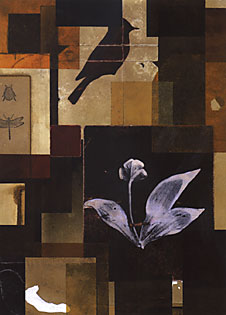 |
|
Photos courtesy of the Joseph Gross Gallery
|
Andrew Young's show "Collages" is on exhibit now through Feb. 21 at the Joseph Gross Gallery on campus. Young uses hand-painted images on layers of paper to create his work.
|
|
By Biz Bledsoe
Arizona Daily Wildcat
Thursday January 30, 2003
Chicago-based artist well-known for use of layers, rich colors
Contrast creates interest. Artist Andrew Young illustrates this concept in his exhibit "Collages," which features layers upon layers of images and delicate hand-painted paper, all contrasting in texture, color and feel. "Collages," an exhibit of Young's work from 1998 to 1999, is at the Joseph Gross Gallery on campus until Feb. 21. The gallery is the exhibit's next-to-last stop after almost two years of traveling to places like Chicago, North Carolina and Germany.
Young has made a name for himself as an artist in the past 15 years through his mastery of the difficult medium of egg tempera and his meditative collages of layered contrasts. Somewhat of a contrast himself, Young began his career as an undergraduate at Berkeley in the ╬80s, initially studying biology but then switching to art.
Despite being an American artist, Young is influenced by Islamic and Asian art. And though his collages appear old and aged, almost sepia-tinged, they are full of contemporary, geometric shapes and patterns. The contrasting levels and textures in Young's collages create a sense of time out of place, and also seem to mirror the contrasts present in the artist. In fact, the presence of the artist has become a major theme in Young's collages. His frequent use of birds indicates the presence of the artist in the work. In ancient Egypt, the bird was the symbol for the soul. Young also uses butterflies, which are the Christian symbol for resurrection, as well as plant figures that look as though they came from old botanical drawings.
Mark it
What: Collages
Where: Joseph Gross Gallery
When: Through Feb. 21, 2003. Monday through Friday, 10 a.m. ¸ 5 p.m. Sunday, 1 ¸ 4 p.m.
Cost: Free
|
"(Young's) work is very elegant," said James Schaub, the curator and director for both the Joseph Gross Gallery and the Lionel Rombach Gallery. "It's not quite minimal; he does off-beat imagery and icons, surfaces, textures and colors."
Known for his use of rich color, Young mixes his own from naturally occurring pigments. His notable use of a particular deep red is the result of a piece of rock he picked up while in Pakistan and used to make pigment.
Another memorable aspect of Young's work is its aged appearance. Through his use of color, texture and the slightly imperfect folding of paper, Young creates a sense of naturally weathered materials.
"(His work) conjures up different associations, namely of antiquities," Schaub said. In addition, "composition is really huge in his work," which revolves around order and formal elements.
Based in Chicago, Young is a world traveler, having studied and taught in places such as Pakistan and Italy. Similarly, his art has been shown around the world, everywhere from Munich to Ecuador. In the Southwest, Young shows his work frequently at the Lisa Sette Gallery in Scottsdale. The 25 pieces in the Collage exhibition, however, are some of his lesser-known pieces that can't be seen in that city.
"The exhibit offers the chance to see work by a well-known artist that he's not really known for," Schaub said. "These works are more intimate; they're a lead into larger works."
Bringing "Collages" to UA has been a three-year process. Julie Sasse, the Joseph Gross Gallery's former curator and now a curator of modern art at the Tucson Museum of Art, was asked to write a catalogue essay about Andrew Young; this eventually led to bringing his work to Tucson and the gallery three years later.
Thus far, "Collages" has seen a good turnout at the gallery. One look at Young's works will tell you why.
"The works are very beautiful, quiet, mellow," Schaub said. "They're very welcoming."

